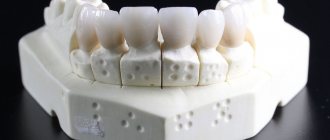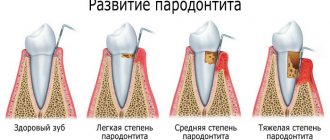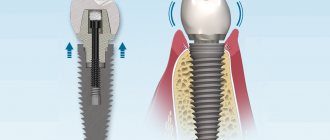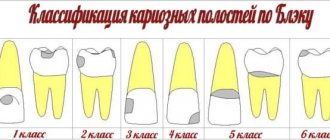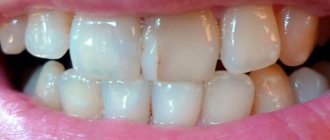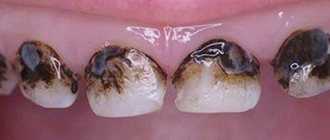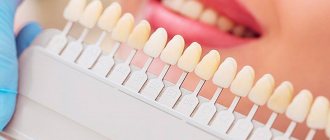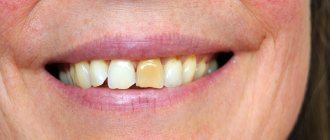The only exception in this case is a mechanical injury to the jaw, against the background of which the patient’s teeth may become loose and even spontaneously be lost. In other situations, the appearance of such problems is observed mainly in old age or in the presence of concomitant pathologies. The appearance of such a symptom as tooth mobility should never be underestimated or ignored. Over time, this can even lead to edentulism (complete or partial loss of teeth). It must be said that with certain periodontal diseases, traditional restoration is not always possible. We urge you to promptly contact specialists if you have such alarming signs, or better yet, regularly attend dental examinations for preventive purposes.
Physiological and pathological mobility
Physiological tooth mobility is invisible to you, but it is activated whenever you eat solid food. This is due to the presence of specific shock absorption of the ligamentous apparatus, due to which the chewing load is distributed evenly across the jaws. In the absence of such a reflex, our teeth would very quickly deteriorate and begin to collapse. Especially those who, by definition, have to withstand the majority of the functional load. Noticeable tooth mobility is almost always pathological in nature. Most often, the appearance of such a symptom is associated with the development of periodontitis - an inflammatory process in periodontal tissues, due to which gradual destruction of the ligamentous apparatus and jaw bones occurs. Periodontitis usually has an infectious origin, and it must be treated urgently, at the first detection of its symptoms. If there are pathological causes, tooth mobility is classified according to severity. In the two early stages of the development of the symptom, the teeth become loose in a forward and backward direction, and the range of movements varies in intensity. At the third stage, the tooth also begins to move laterally, and at the final, fourth stage, it can rotate around its own axis. Unfortunately, the final stage of tooth mobility is a direct indication for their removal. In the first stages of loosening, treatment is possible, but it is lengthy and quite complex.
Dental treatment at an affordable cost can be successfully carried out in our dental clinic of Dr. Granov.
Professional help from specialists is mandatory in the matter of eliminating tooth mobility.
First of all, it is necessary to regularly seek preventive examinations to prevent common diseases of the oral tissues.
Leave your phone number. The clinic administrator will call you back.
By leaving a request on the site, you consent to the processing of personal data
Make an appointment
Initial consultation with a dentist
For free!
Classification of tooth mobility
In modern dental practice, to determine the degree of unnatural mobility of teeth, the classification developed by Honored Scientist of Russia David Abramovich Entin is most often used.
According to this typology, the following levels of mobility are distinguished:
- I degree (instability of position in relation to the coronal parts of adjacent teeth in the oral-vestibular or bucco-lingual directions, amplitude of movement less than 1 mm);
- II degree (mobility in similar directions with an amplitude of more than 1 mm, the appearance of movements in the distal-palatal direction);
- III degree (ability to move in all directions, including vertical);
- IV degree (adding rotational movements of the diseased tooth around its own axis).
Causes of loose teeth
There are many reasons for pathological tooth mobility, and you should find out the catalysts for the disorder in your case by contacting a specialist. At Dr. Granov’s dental clinic you will be provided with timely, competent assistance in the diagnosis, treatment and prevention of diseases of the teeth and periodontal tissues.
Teeth begin to move for the following reasons:
- The presence of inflammatory processes in the internal structures of the periodontium;
- Atrophic processes in the alveolar processes of teeth;
- Endocrine disorders and hormonal imbalance in the body;
- Incorrect bite or incorrect position of some teeth in rows;
- Shortening of the frenulum of the tongue;
- Pathological structure of the tissues of the dentofacial apparatus;
- Untimely or incorrect fixation of dentures (including bridges) or implants after the loss of some teeth;
- Mechanical injuries of teeth and jaws (including fractures);
- Medical errors made by incompetent or unscrupulous dentists in the process of treating certain diseases of the oral cavity;
- Poor oral hygiene, against the background of which pathologies of teeth and soft tissues develop.
If one or more teeth are loose, you should seek professional help as a matter of urgency.
A simple way to stabilize loose teeth is splinting
We combine moving elements into a single block with healthy teeth using a special fiberglass or orthodontic retainer:
- the splint is applied to the teeth and fixed with a light-curing composite material matched to the color of the enamel;
- The retainer is installed just as discreetly, but instead of clear fiberglass, orthodontic wire is used.
Both structures are invisible to others and do not interfere with eating or speaking. At the same time, they prevent displacement, slow down bone atrophy and complete tooth loss.
What to do if loosening occurs?
If you notice your teeth are moving, immediately make an appointment with a dentist. The specialists at Dr. Granov’s clinic are ready to help you at any time. We urge you not to ignore your symptom, since subsequently the treatment of the provoking pathology can become very complicated.
While you are at home, try to follow three basic rules:
- Never loosen the tooth with your fingers or tongue. Try not to touch it at all, so as not to aggravate the current situation;
- Rinse your mouth with warm water (or a mild saline solution), but do not brush your teeth with a brush or toothpaste;
- If a tooth falls out, see a doctor immediately. If this has just happened, you still have the option of emergency implantation. The more you delay the process, the less opportunities there will be for high-quality restoration.
When a tooth falls out, we must not forget that parts of it may still remain inside the gums. And this can also have very dangerous consequences for you if you continue to ignore the warning signs.
If the cause of mobility is tartar, we will carry out cleaning
Plaque and tartar push the gums away from the crown and form periodontal pockets. Inflammation occurs, the development of multiple caries and destruction of periodontal joints.
After professional cleaning, the swelling subsides and bleeding decreases. If the pockets are deep, we perform curettage to remove subgingival plaque, hardened deposits and bacteria. According to indications, we simultaneously use bone reconstructive surgery.
Our experience shows that the effect will be long-lasting if the patient approaches home hygiene responsibly. We will adjust your technique, select brushes and pastes. The periodontal tissues will gradually become stronger and the pockets will tighten.
How can we help you?
Find out from a specialist exactly how you should care for your teeth at home, and how to correctly use products designed for your problems and risks.
Refer to professional hygienic cleaning procedures in a timely manner to detect current problems and maintain dental health. In case of malocclusion , our specialists will select the optimal orthodontic therapy for you. It can consist of both conservative and surgical methods of correction.
If the cause of mobility in your case is periodontitis , our specialists will select the latest comprehensive treatment for you. It may also include medications and surgical methods. For high-quality prevention of complications, you will need to follow all instructions and recommendations of a specialist. Sometimes an acceptable solution for loose teeth is splinting them. But this option is not effective in all cases, and then the treating specialist decides to use other methods of treatment. If a tooth is lost, its implantation or prosthetics is indicated. Our specialists perform all types of similar services:
- Removable and fixed prosthetics;
- Implantation;
- Restoration of one or more teeth, as well as complete restoration of the dentition.
Tooth mobility of the fourth degree requires their surgical removal. The decision on the subsequent installation of prostheses or implants is made on an individual basis, taking into account the characteristics of each case.
If you notice even weak mobility of a molar, contact our dental clinic of Dr. Granov. We will provide you with the most effective and timely assistance in eliminating your problem and give valuable advice regarding the subsequent prevention of oral diseases.
Symptoms accompanying mobility
In fact, there is only one symptom - when you touch a tooth with your finger, tongue or any object, as well as during eating, its mobility is clearly felt. As a rule, horizontally, that is, a shift to the right-left or forward-backward. Other symptoms are mainly associated with the underlying disease and, as a rule, we are talking about inflammation of the gums, exposure of the roots, the formation of copious amounts of deposits under the soft mucous membranes, even rotting of the contents of periodontal pockets.
Treatment
When selecting a treatment regimen, the dentist takes into account:
- the general health of the patient;
- the reason for the violation;
- condition and location of the tooth;
- degree of loosening.
If the disorder is caused by internal processes, for example, hormonal imbalance or endocrine disease, then you need to work with the root cause. If the unit has become mobile due to injury or destruction of periodontal tissue, the question of splinting arises - installing a special dental structure that forces the crown to constantly be in one position.
Types of splints used in treatment
To relieve a person from severe mobility of fangs, molars, and incisors, doctors use the following splinting systems:
- Ring. Metal rings connected to each other are put on top of the crowns. As a result, mobile units become more stable.
- Semi-circular. It works in a similar way to the previous one, but the elements used look like half rings rather than rings. To achieve better aesthetics, they are fixed on the back side of the dentition, so when you smile they are almost invisible to others.
- Cap. The tire includes small caps connected to each other. They cover the cutting edges and partially extend onto the surface of the crowns.
- Coronal. Movable teeth are pre-ground and then covered with dental crowns. On both sides of the bridge, one healthy, stable unit is ground. Due to this, progression of loosening becomes impossible.
- Tab. This treatment option is similar to the cap treatment. Only here they don’t put caps on top of the crowns, but make indentations in the cutting surface of the teeth and place special miniature inlays in them. It turns out that all units of the row are reliably connected to each other.
Splinting is not always effective. If the abnormal process is severely advanced, then after a while the teeth begin to loosen again. But in most cases, doctors still manage to eliminate mobility using splints.
Manifestations of the problem
In addition to loose teeth, patients may experience the following symptoms:
- Bleeding gums;
- Increased sensitivity to temperature changes, chemical irritants;
- Redness, swelling of the gums;
- Bad breath;
- Purulent discharge;
- Pain in the gum area.
In dentistry, doctors try to quickly and with minimal risk of relapses restore reliable fixation of the dentition. Dentists are sure to check for additional symptoms in order to deal with them and identify the cause of loosening.
Relevance.
Tooth mobility is one of the symptoms characterizing the severity of periodontal pathology. Dentists, conducting an initial examination, determine the “degree of tooth mobility.” Assessing the success of the treatment, the fact of “gaining greater stability by the mobile teeth” is recorded. That is, in dental discourse, the concepts of “mobility” and “stability” of teeth act as a binary opposition, which, in our opinion, is unfounded. B.P. Markov and K.A. Morozov (2004), having developed a two-parameter periodontometer, assessed equilibrium and nonequilibrium tooth mobility. They proved that tooth mobility at a relative physiological norm is 6.2 µm/n. E.V. Kabanova (2010) found that in people suffering from mild periodontitis, tooth mobility increases by 8-9 times, and with moderate severity - by 10-12 times.
Purpose of the study
— a comparative assessment of the response of periodontal tissues to the occlusal load that occurs after restoration of the viability of the proximal contacts by filling stable premolars and premolars that have lost more than 10% of the projection of the support area.
Material and methods.
The study involved patients (
n
=52) with carious cavity(s) on the approximal surface(s) of premolars.
Based on tomographic studies, assessing the loss of the projection area of the support of the premolars, limiting the defect of the dental arch, two groups of patients were formed. Group 1 ( n
=25) included patients in whom the projection of the intraalveolar part of the premolars, limiting the dental arch defect, and the contralateral teeth, which have pronounced approximal contacts, did not differ.
The 2nd group was formed from patients ( n
= 27) in whom the projection of the intraalveolar part of the premolars, limiting the dental arch defect, differed by more than 10% from the projection of the intraalveolar parts of the contralateral teeth. To assess periodontal stress damage in the premolar area, after 20 minutes of consuming 1/5 of a pack of chewing gum, gingival fluid (GF) exudation was determined. When the dental arch defect was localized in the upper jaw, the size of the impregnation area was compared with the reference value of 0.253±0.08 cm2, in the lower jaw - with the value of 0.229±0.04 cm2. These values correspond to the arithmetic average area of liquid impregnation of filter paper strips in the area of premolars with intact periodontium. Structural and functional changes in the periodontal blood supply were assessed using laser Doppler flowmetry. The next day, the integrity of the dental arch was restored by remodeling the approximal contacts of the premolars with filling. After 1 month, the patients were examined to assess the response of the premolar periodontium to occlusal load.
Results.
In the absence of approximal contacts, the impact of occlusal load leads to an increase in disc exudation in the area of the teeth with a constant projection area of the intraalveolar part by 42.6-44.9%. In the area of teeth, the projection area of the intraalveolar part has decreased by 10%, this figure increases by 96.9-99.2%. Functional changes in capillary blood flow are also more pronounced in group 2, in which vasomotor activity of vessels decreased by 23.7%, in group 1 - by 11.6%. 1 month after restoration of proximal contacts, the impact of occlusal load leads to an increase in disc exudation in group 1 by 25.2-31.4%. According to the LDF data, no significant changes in vasomotor activity were detected in group 1. Occlusal load leads to functional hyperemia. In group 2, the volume of disc exudation increased by 62.4–64.4%. A 14.1% decrease in vasomotor activity indicates the persistence of venous stagnation.
Conclusion.
Having accepted the projection of the support area, estimated in cm2, as a qualifying indicator of tooth stability, it becomes possible to distinguish between the concepts of “tooth mobility” and “tooth stability”, since tooth mobility has a dimension of µm/n. The different response of the periodontium of teeth with a reduced and unchanged projection of the support area to the occlusal load after restoration of the viability of the proximal contacts allows us to consider their remodeling as a mechanism for restoring the “reversible” stability of the teeth. “Irreversible” tooth stability is characterized by the presence of a reduced projection of the support area.
When all your teeth are loose – what to do?
In cases where there is mobility of almost all the teeth in the mouth, it is necessary to urgently contact a dentist so as not to lose them. A comprehensive examination will help identify the cause of mobility and, if possible, eliminate it. To limit mobility and prevent further loosening and loss of teeth, the dentist will perform splinting. Further treatment tactics will depend on the cause of mobility and its degree - most often such mobility is provoked by periodontitis or periodontal disease, so it is necessary to eliminate these diseases whenever possible.
It also happens that the lower front teeth become loose, what to do in such a situation? Find out whether the patient suffers from bruxism (uncontrollable grinding of teeth during sleep), since this pathology can cause just such mobility.

